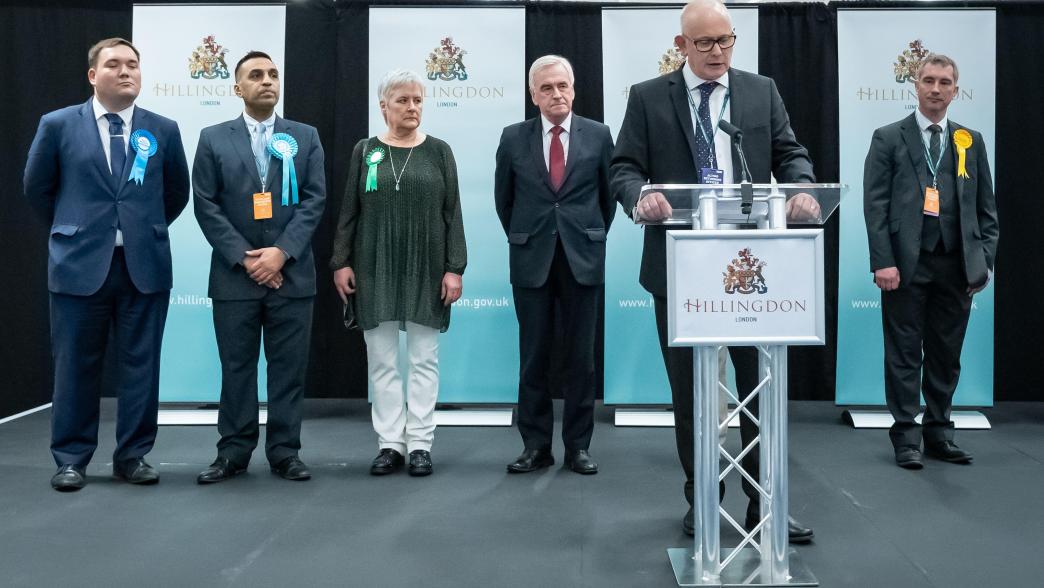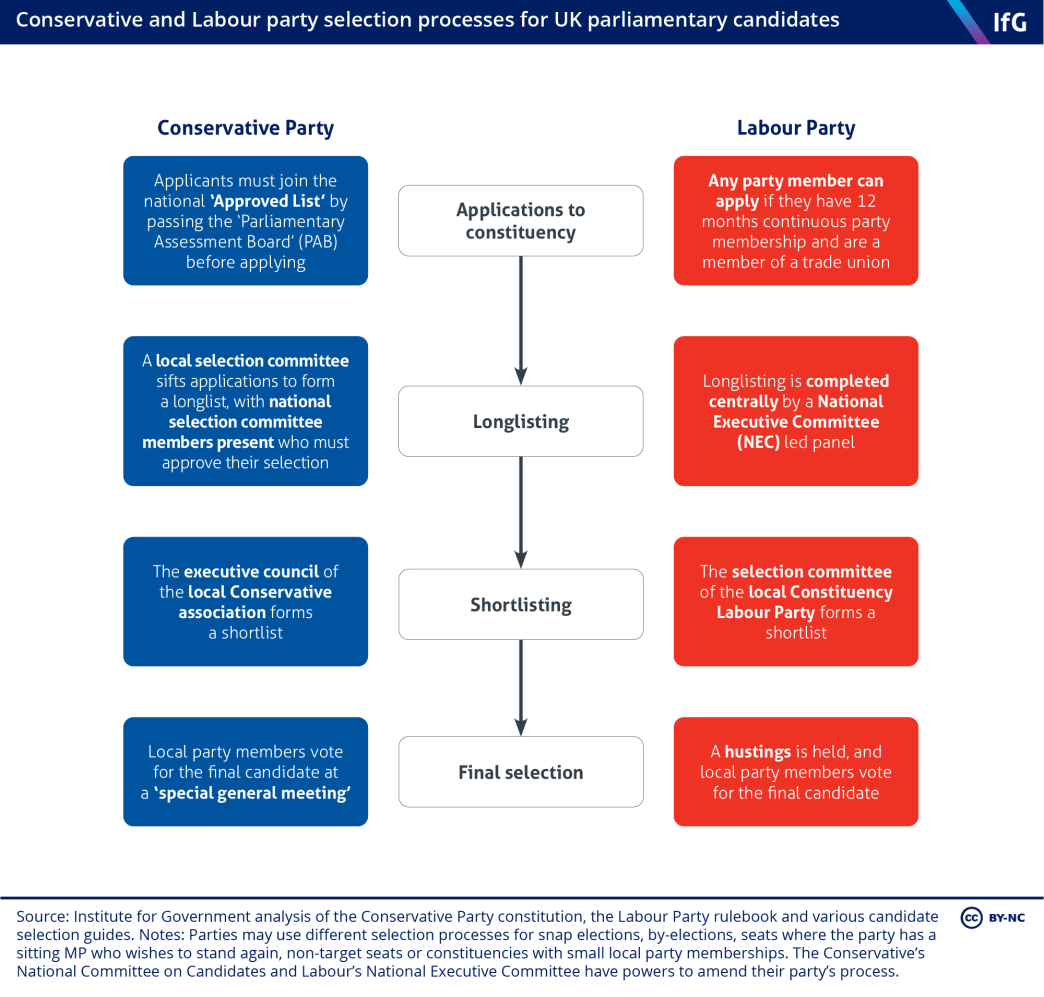Conservative and Labour party selection of UK parliamentary candidates
How do the Conservatives and Labour choose who will stand for them in elections?

Before a general election, political parties must select a candidate to stand in every seat they plan to contest. While candidates can stand as independents, all 650 MPs elected at the 2019 general election represented a political party.
In the UK’s representative democracy, MPs are not only responsible for representing their constituents but also making laws by passing legislation, and holding the government to account. The government itself is formed of MPs – from junior ministers right up to secretaries of state and the prime minister, alongside some members of the House of Lords.
This means the candidates selected for each party have an important role in shaping parliament and the government, and by extension the wider political system.
How similar are the selection processes between the parties?
Each political party has its own process for selecting parliamentary candidates. These are set out in the parties’ constitutions, with more detailed procedures published separately (and subject to change over time). For both Labour and the Conservative parties, a national committee is at the core of the selection process, but the balance between national decision making and local autonomy varies.
For by-elections or snap elections, where parties have less time to select their candidates, the parties’ constitutions allow for a different selection process to be used. These are typically more centralised and streamlined.

How are Conservative Party candidates selected?
A national Committee on Candidates oversees Conservative candidate selection in England and Wales. 26 Conservative Party, ‘Constitution of the Conservative Party’, January 2021, retrieved 3 November 2023, https://public.conservatives.com/organisation-department/202101/Conservative%20Party%20Constitution%20%20as%20amended%20January%202021.pdf The committee last published rules for this process in 2022. 27 Conservative Party, ‘Selection of Conservative Party Candidates in England, Wales and Northern Ireland’, Conservative Post, 2 March 2022, retrieved 3 November 2023, https://conservativepost.co.uk/wp-content/uploads/2023/02/Rules-for-the-Selection-of-Conservative-Party-Candidates-in-England-Wales-and-Northern-Irel… The Scottish Conservative and Unionist Party has oversight of candidate selection in Scotland. The process in England and Wales comprises broadly four steps:
1. Applications
To apply to stand as a Conservative MP, prospective candidates must first join the national ‘approved list’. Prospective candidates must complete an application form and attend a parliamentary assessment board (PAB) – an event to test the skills and attributes the party want from their candidates. Due diligence checks are also carried out at this stage. Candidates who make it onto the approved list are then able to apply to individual constituencies.
2. Longlisting
Each local Conservative association forms a selection committee, which sifts through applications to narrow them down to no more than eight candidates. Despite this committee being formed of local party members, the sifting process takes place at national party headquarters with members of the national Committee on Candidates present to advise and agree on the selection. Selection rules state that ‘due regard must be given to a gender balance’ during this process. 28 Conservative Party, ‘Selection of Conservative Party Candidates in England, Wales and Northern Ireland’, Conservative Post, 2 March 2022, retrieved 3 November 2023, https://conservativepost.co.uk/wp-content/uploads/2023/02/Rules-for-the-Selection-of-Conservative-Party-Candidates-in-England-Wales-and-Northern-Irel…
3. Shortlisting
The selected applicants are interviewed by the executive council of the constituency’s Conservative association. The executive council then vote on a shortlist to be put to local party members.
The selection rules allow for optional competency tests or community involvement at this point – introduced in the 2022 selection rulebook. 29 Conservative Party, ‘Rules for the selection of Conservative Party Candidates in Target and Conservative held seats in England, Wales and Northern Ireland for the UK Parliament’, Wealdon Conservatives, September 2018, retrieved 3 November 2023, https://www.wealdenconservatives.com/sites/www.wealdenconservatives.com/files/2019-01/Rules%20for%20the%20Selection%20of%20Candidates.pdf Another key change in the 2022 rulebook was the removal of the optional primary selection process, introduced in 2003 as part of efforts to make the party more representative. Under primary selection, any local party member or voter in the constituency could register to attend the hustings and vote for the Conservative Party candidate, from among those shortlisted. Primaries reached their peak at the 2010 election, with 118 parliamentary candidates being selected in this way. 30 Alexandre-Collier A. The Open Garden of Politics? The Conservative Leadership's Management of Open Primaries for Candidate Selection. Presented at ‘UK Political Studies Association Annual Conference, Sheffield 2015 Mar (Vol. 30).’
4. Final selection
All local Conservative association members are invited to a ‘special general meeting’ to hear speeches from those shortlisted, ask questions, and then vote for their parliamentary candidate.
Alternative selection processes
Local Conservative associations with fewer than 150 members have a shortened selection process, with fewer stages and less involvement of the local executive council.
Sitting Conservative MPs are not automatically re-selected; they must ask the local executive council to be readopted as the candidate. If the execute council vote against this request, the MP may request a ballot of the full local association membership.
How are Labour Party candidates selected?
Labour Party candidate selection in England is determined by the National Executive Committee (NEC). The Scottish and Welsh executive committees are responsible for selections in their nations; they each issue separate processes for local parties to follow, but the NEC retains “absolute power to cancel or amend procedures for selections” across the UK. 36 Labour Party, Rule Book 2023, retrieved 3 November 2023, https://labour.org.uk/wp-content/uploads/2023/01/Rule-Book-2023-FINAL_web_v3.pdf
1. Applications
The Labour Party does not formally have a national approved list of candidates. Any party member can apply to any individual constituency party that is advertising for candidates, as long as they fulfil the following criteria: continuous membership of the party for 12 months, membership of a TUC-affiliated trade union, and that they have not previously been disqualified as a local government candidate.
2. Longlisting
Prospective Labour candidates apply to individual constituencies. Under the selection process determined in 2022, applications for each constituency are reviewed centrally by an NEC-led panel to create a longlist. 37 Labour Party, Procedural Guidelines for Westminster Parliamentary selections where there is a vacancy, retrieved 3 November 2023, https://labour.org.uk/wp-content/uploads/2023/10/Procedural-Guidelines-for-the-Selection-of-Westminster-Parliamentary-Candidates-v2.pdf Candidates nominated by a trade union or other party-affiliated organisation are automatically longlisted, while others have a political interview before a decision is made. The longlist should be at least 50% women and include one or more minority ethnic candidate.
A due diligence process runs alongside this, aiming to highlight any concerns that could damage the party should the candidate be selected. Any candidate can be prevented from progressing at this stage.
3. Shortlisting
Constituency Labour parties form a selection committee, which conducts interviews and forms a shortlist of at least two candidates to be put to local party members. Again, this shortlist should be at least 50% women and include one or more minority ethnic candidates. Any candidate nominated by more than half of local party branches is automatically shortlisted.
4. Final selection
Shortlisted candidates are invited to a hustings and local members vote for their parliamentary candidate via a preferential voting system (Alternative Vote). Members rank candidates in order of preference, with the candidates receiving the fewest first preference votes being eliminated and their votes redistributed until one candidate has a majority.
Alternative selection processes
In Scotland, candidates apply to a pair of ‘twinned’ constituencies. 38 Andrews K and Boothman J, ‘Douglas Alexander to return as Labour candidate’, The Times, 13 February 2023, retrieved 19 October 2023, https://www.thetimes.co.uk/article/douglas-alexander-to-return-as-labour-candidate-8vztzh835 The membership of the two local Labour parties is combined for the selection, and the male candidate and female candidate with the most votes become the candidates for the two seats. The candidate who receives the most votes chooses which of the two seats they wish to stand in. This process was introduced to ensure equal gender representation among candidates. 39 Bradbury J, Mitchell J, Bennie L, Denver D. Candidate selection, devolution and modernization: The selection of labour party candidates for the 1999 Scottish parliament and Welsh assembly elections. British Elections & Parties Review. 2000 Jan 1;10(1):151-72.
In 2023, Labour’s NEC voted to adopt a streamlined process for ‘non-priority’ seats, initially defined as those with a Conservative majority of over 40%. 40 Labour Party, Procedures for the selection of non-priority Westminster parliamentary selections in England, retrieved 3 Nov 2023, https://labour.org.uk/wp-content/uploads/2023/07/Procedures-for-the-selection-of-non-priority-seats.pdf Applications are reviewed by the NEC for due diligence concerns, but then move straight to shortlisting by the local party, by-passing the centrally run longlisting process. An NEC representative must sign off the shortlist for selection to proceed.
If a sitting Labour MP wants to stand for re-election, a trigger ballot is held. If more than half of local party branches and affiliates (trade unions and socialist societies) vote for a selection to take place, then a selection process is run to draw up a new longlist, and then shortlist, of candidates. The sitting MP is, however, automatically included on the shortlist.
- Keywords
- General election Official opposition
- Political party
- Conservative Labour
- Legislature
- House of Commons
- Project
- General election
- Tracker
- Parliamentary Monitor
- Publisher
- Institute for Government